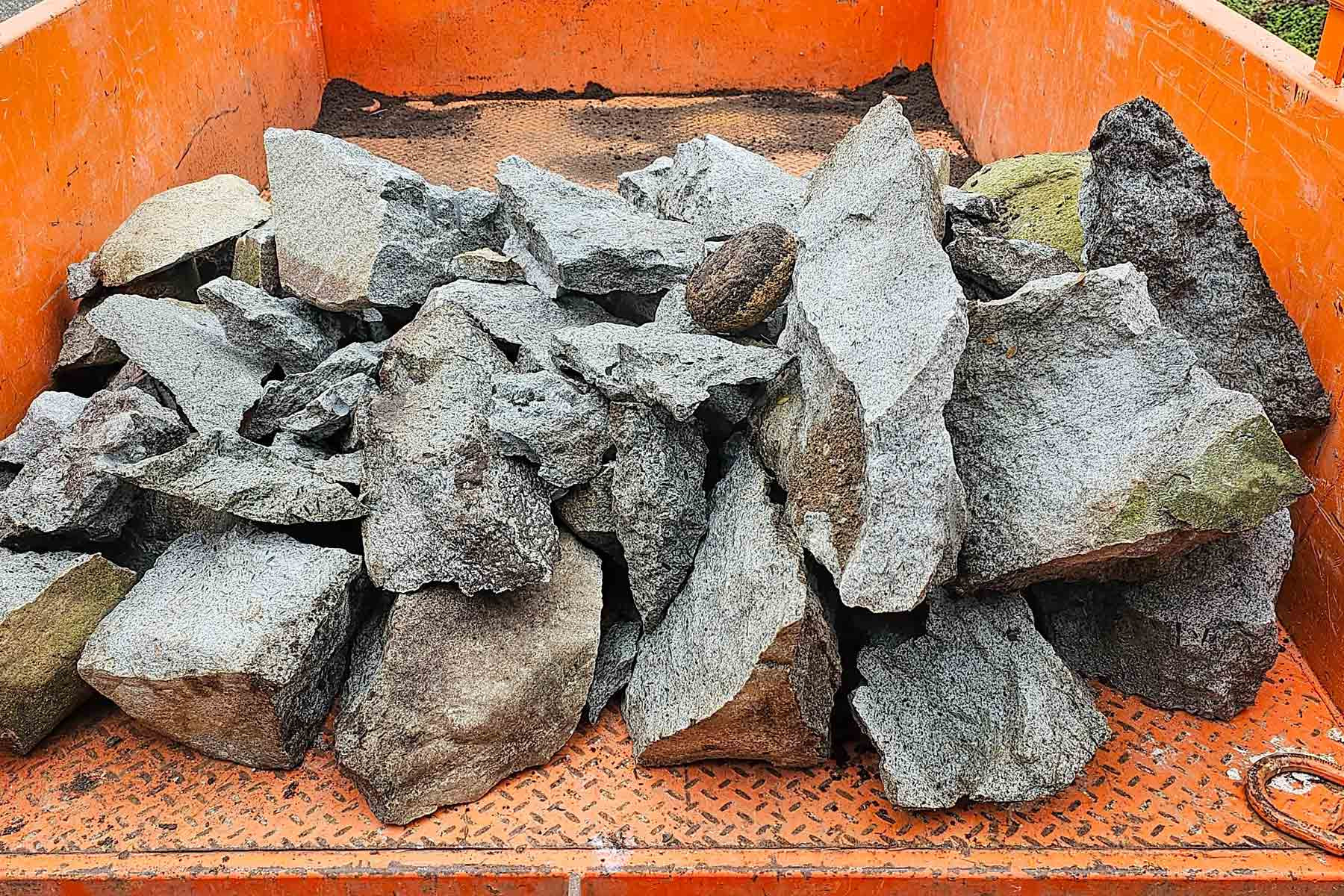Removing rocks from your yard can be a daunting task, but knowing the costs involved is the first step in reclaiming your outdoor space. At rockscapes.net, we understand the desire for a beautifully landscaped yard, and that sometimes means saying goodbye to unwanted rocks. Let’s explore the expenses associated with rock removal, offering solutions to help you achieve your dream landscape. Whether you’re planning a full landscape renovation, need assistance with removing large boulders, or seek expert advice on rock disposal, our resources and network of professionals can guide you toward an affordable and successful outcome.
1. Average Landscape Rock Removal Costs
So, how much will it actually cost to get those rocks out of your yard? The average cost to remove landscape rock ranges from $50 to $250 per cubic yard. The actual cost will depend on several things, including where you live, how difficult the job is, and what you want to do with the rocks after they’re removed.
| Fee Structure | Average Cost |
|---|---|
| Per hour per worker | $50 – $150 |
| Per cubic yard (relocate on property) | $50 – $200 |
| Per cubic yard (remove & dispose) | $220 – $250 |
Note: Disposal fees are not included in hourly rates.
To put that into perspective, one cubic yard is a volume measuring 3 feet wide, 3 feet long, and 3 feet tall. A cubic yard of rock could fill about 9 to 14 standard wheelbarrow loads. Keep these factors in mind as we delve deeper into the cost components.
2. Landscape Rock Removal Cost by Load Size
The size of your rock removal project significantly impacts the overall cost. The more rocks you need removed, the higher the expense. Here’s a breakdown of average removal costs based on load size:
| Load Size | Average Cost to Relocate | Average Cost to Remove |
|---|---|---|
| Small (up to 2 cubic yards) | $100 – $400 | $440 – $500 |
| Medium (4 cubic yards) | $200 – $800 | $880 – $1,000 |
| Large (6 cubic yards) | $300 – $1,200 | $1,300 – $1,500 |
These estimates provide a general idea, but your actual costs may vary. It’s always best to get a professional quote.
 Landscaping rocks being transported in a truck bed
Landscaping rocks being transported in a truck bed
2.1. Boulder Removal Cost
Removing boulders is a different beast altogether. Boulder removal can cost anywhere from $250 to $1,000 or more, depending on size and site conditions.
Here’s why boulder removal is more expensive:
- Heavy Equipment: Excavators or skid steers are often necessary.
- Labor and Safety: Requires more workers and careful planning.
- Specialized Transportation: Boulders are heavy and awkward to move.
In some cases, workers may need to drill and split the boulder into smaller pieces for easier transport.
3. Landscaping Rock Removal Cost Factors
Several factors influence the total cost of your rock removal project. Understanding these can help you budget more accurately and potentially save money.
3.1. Accessibility
How easy is it to access your yard? Limited access or backyard obstacles can increase costs by 25% to 50%. Think about it: if workers have to haul rocks by hand because a truck can’t get close, it’s going to take longer and cost more.
3.2. Project Size
The volume of rock directly affects the total cost. Small projects (under 5 cubic yards) cost less overall but may cost more per yard. Larger projects (over 20 cubic yards) might qualify for volume discounts.
3.3. Soil Type & Terrain
Slopes or unstable soil conditions increase labor and equipment needs. Removing rocks from difficult terrain requires extra safety measures and specialized equipment, which translates to higher costs.
3.4. Permit Requirements
Most basic rock removal projects don’t require permits. However, larger projects or work in protected areas may need local permits. These permits add to the overall cost, so it’s important to check with your local authorities.
3.5. Local Disposal Fees
Landfill fees range from $30 to $60 per ton if you haul the rocks yourself. Professional services charge $50 to $250+ for disposal, which includes landfill fees, travel time, labor, and vehicle wear and tear.
3.6. Equipment Needs
Basic hand tools are usually included in standard rates. However, if your project requires heavy equipment like excavators or skid steers, you’ll incur additional costs.
3.7. Labor Costs
The labor cost to remove landscape rock typically ranges from $50 to $150 per hour per worker. Most residential projects need 2 to 3 workers. Hiring an excavator with their own equipment can cost $100 to $300 per hour for larger projects. Remember, these hourly rates usually don’t include transportation or disposal fees.
4. Rock Removal & Disposal Methods
The best way to get rid of unwanted rocks depends on how much you have, why you’re removing them, and whether you want to do it yourself.
4.1. New Landscaping Project
If you’re removing rocks for a new landscape design, some contractors may include rock removal in the overall cost of the new landscaping installation. They might even be able to reuse some of the old rocks in the new design, saving you money on removal and disposal.
4.2. Junk Removal Service
Hiring a junk removal service costs $400 to $500+ to remove a full truckload. This is a good option for smaller rock removal projects. Get an on-site estimate to ensure an accurate quote, as labor costs can vary widely depending on the rocks’ size, number, and ease of removal.
4.3. Dumpster Rental
Renting a dumpster costs $220 to $580 per week for a 10-yard roll-off dumpster. This size fits 3 to 4 pickup truck loads and is the most common for landscape rock removal. Anything larger may be too heavy to haul when filled with rocks.
If you’re doing it yourself, factor in the cost of tools and supplies like gloves, a rake, a shovel, and a wheelbarrow. A dirt sifter is handy for smaller rocks, while a metal pry bar can help with larger ones. Renting a mini excavator costs $200 to $700 per day.
5. Search Intent
Let’s explore the various reasons why someone might be searching for information on rock removal costs. Here are five key search intents:
- Cost Calculation: Users want to estimate the cost of removing rocks from their yard.
- DIY vs. Professional: Users are comparing the costs of DIY rock removal versus hiring a professional.
- Disposal Options: Users seek information on where to dispose of rocks and the associated costs.
- Project Planning: Users are planning a landscaping project and need to factor in rock removal costs.
- Troubleshooting: Users are looking for solutions to challenges encountered during rock removal.
6. Understanding Key Considerations for Accurate Cost Estimation
Estimating the cost of removing rocks involves various aspects, starting with the size and scope of the task. A yard filled with numerous small stones presents a different challenge compared to one featuring a few massive boulders. Each scenario necessitates different equipment, manpower, and disposal strategies, which directly affect the overall expense.
The physical accessibility of the rocks is another critical factor. Rocks situated in an easily accessible, flat terrain are simpler and less costly to remove than those located on steep slopes or in areas with limited access for machinery.
Moreover, the type of rock plays a significant role. Lighter, more manageable stones are easier to handle, whereas dense, heavy rocks require specialized equipment, increasing labor time and, consequently, costs.
Lastly, disposal methods significantly influence the final cost. Options range from hiring a junk removal service, which charges by volume, to renting a dumpster, which involves separate fees for the rental period and disposal. Alternatively, some individuals may choose to repurpose the rocks elsewhere on their property or offer them for free to others, thereby reducing disposal expenses.
7. Getting Quotes from Professionals
When estimating the price of removing rocks, it’s important to understand the details of how different rock removal services provide quotes. Many companies offer free on-site estimates, where they assess the project and provide a detailed quote. This is the most accurate way to get a sense of what your project will cost.
7.1. Understanding the quote
- Be sure the quote includes all aspects of the job including labor, equipment, and disposal.
- Ask about any potential additional fees.
- Check the company’s reviews.
7.2. Evaluating Expertise
- Be sure to confirm the company is licensed, bonded, and insured.
- Ask for references and check their work.
- Confirm how many years the company has been in business.
7.3. Comparing Quotes
- Get at least three quotes from different companies.
- Compare the itemized costs and services included.
- Don’t automatically go with the lowest quote, consider the company’s reputation and experience.
8. Optimizing Your Rock Removal Budget
Getting rid of unwanted rocks can be manageable by employing different strategies to optimize the budget. Start by accurately assessing the scope of the project. Understanding the volume, size, and type of rocks involved will allow for more precise cost estimations.
Consider DIY options for smaller projects or for tasks such as transporting rocks to a disposal site. Renting equipment instead of hiring professionals for the entire project can also reduce expenses. Additionally, explore alternative disposal methods, such as repurposing the rocks in other landscaping projects or offering them for free to neighbors or community gardens.
Scheduling the rock removal during off-peak seasons might result in lower rates from contractors. Obtaining multiple quotes from different service providers and comparing them will help identify the most competitive pricing. Negotiating prices based on the project’s scope and potential discounts can further contribute to cost savings.
Pro Tip: Remember, rockscapes.net is your partner in this journey, offering advice and connecting you with local experts.
9. Landscape Rock Removal FAQs
9.1. What is the easiest way to remove landscape rocks?
The easiest way to remove landscape rocks involves a mix of tools and techniques to minimize effort. For small DIY projects:
- Use a shovel to loosen rocks.
- Use a lawn rake to gather them.
- For larger embedded rocks, use a pry bar or pickaxe.
- Transport rocks with a wheelbarrow.
- Consider renting a rock vacuum or mini excavator to save time and energy.
For large projects or boulders, hiring a professional is recommended for safety and proper equipment usage.
9.2. Where can you dispose of landscape rocks?
Several disposal options are available:
- List rocks for free on marketplace websites.
- Local landscaping companies.
- Construction recycling centers.
- Community garden projects.
- Reuse stores like Habitat for Humanity ReStores.
- Landscape supply yards.
- Municipal waste facilities.
9.3. What size dumpster do I need for landscape rock disposal?
A 10-yard dumpster is typically the best choice. Landscaping rocks are heavy, so filling a larger dumpster may make it too heavy to haul away.
9.4. How do I prepare my yard for rock removal?
Preparing your yard involves clearing vegetation, marking underground utilities, and ensuring accessibility for equipment.
9.5. What safety precautions should I take when removing rocks myself?
Wear safety gear like gloves and eye protection. Use proper lifting techniques to avoid back injuries.
9.6. Can I recycle landscape rocks?
Yes, recycling options include using them in other landscaping projects or donating them to local construction or landscaping companies.
9.7. What are the environmental considerations of rock removal?
Consider erosion control, proper disposal methods, and the impact on local ecosystems.
9.8. How can I prevent rocks from returning to my yard after removal?
Implement measures like installing landscape fabric, improving drainage, and selecting appropriate ground cover.
9.9. Are there any tax deductions or rebates for rock removal?
Check with local authorities for potential deductions or rebates related to landscaping improvements.
9.10. What is the best time of year to remove rocks from my yard?
The best time is typically during the fall or early spring when the weather is mild and the ground is not frozen or overly saturated.
10. Getting Estimates From Rock Removal Companies
When searching for a rock removal service, be sure to:
- Get 3+ on-site estimates to compare.
- Verify the company is licensed, bonded, and insured.
- Look for companies with positive reviews on HomeGuide and Google.
- Request a detailed written estimate.
- Be cautious of extremely low quotes, as they may indicate inferior work or lack of experience.
- Don’t pay in full until the job is complete.
Asking the right questions ensures you hire the right pro. Here are some key questions to ask:
- How many years have you been in business?
- Are you licensed and insured to perform this job in this location?
- Do you have references I can contact?
- Where do you dispose of the rocks?
- Will you provide a written estimate with a breakdown of all costs?
- Does the estimate include all removal, disposal, and travel expenses?
- Are there any additional fees besides what you’ve quoted?
- How many people will be working on this?
- How soon are you available for this removal job?
11. Conclusion: Transform Your Yard Today
Removing rocks from your yard doesn’t have to be a headache. By understanding the costs involved and exploring your options, you can achieve the landscape of your dreams.
Ready to take the next step? Visit rockscapes.net today for more inspiration, detailed information on various rock types, and expert advice to make your landscaping project a success. Don’t wait – create the outdoor space you’ve always wanted!
Explore stunning design ideas, learn about different rock types, and get tips from our experts. Contact us today to start your landscaping transformation!
Address: 1151 S Forest Ave, Tempe, AZ 85281, United States
Phone: +1 (480) 965-9011
Website: rockscapes.net

